Did you know that cipollini onions have been a staple ingredient in Italian cuisine for centuries? These small, disc-like onions may be petite in size, but they pack a big punch when it comes to flavor. With their sweet and mild taste, cipollini onions can turn any dish into a culinary masterpiece.
Whether you’re a seasoned cook or just starting out in the kitchen, learning how to cook cipollini onions is a game-changer. In this article, I’ll share my personal tips and techniques for bringing out the best flavors in cipollini onions. From roasting to caramelizing, we’ll explore various cooking methods that will elevate your dishes to a whole new level.
Key Takeaways:
- Discover the unique flavor and versatility of cipollini onions
- Learn how to cook cipollini onions to perfection
- Explore the health benefits and nutrition of cipollini onions
- Find out the best substitutes for cipollini onions in your recipes
- Get inspired with delicious cipollini onion recipes
The Versatility of Cipollini Onions
Cipollini onions are incredibly versatile and can be used in a variety of recipes. Whether you’re looking to add sweetness to your favorite dishes or wanting to experiment with different flavors, cipollini onions are a fantastic choice. Here are some exciting ways you can use cipollini onions in your cooking:
Caramelized Cipollini Onions
When caramelized, cipollini onions transform into a deliciously sweet and tender topping. The slow cooking process allows their natural sugars to caramelize, creating a rich, deep flavor. Use caramelized cipollini onions to enhance the taste of burgers, pizzas, or as a delightful addition to gourmet sandwiches.
Roasted Cipollini Onions
Roasting cipollini onions brings out their natural sweetness and intensifies their flavor. The onions become soft and golden brown, making them an excellent side dish to accompany roasted meats, poultry, or even roasted vegetables. The slight char from roasting adds a smoky note that pairs well with various savory dishes.
Pickled Cipollini Onions
If you’re looking to add a tangy twist to your salads or sandwiches, pickled cipollini onions are the way to go. The brine infuses the onions with a delightful tartness and preserves their crunch. Enjoy these pickled onions as a zesty condiment, a vibrant salad topping, or a flavorful addition to charcuterie boards.
By exploring these different cooking methods, you can unlock the full potential of cipollini onions in your culinary creations. Whether you’re aiming for sweetness, richness, or tanginess, these versatile onions are sure to impress your taste buds.
To give you some inspiration, here’s a mouthwatering cipollini onion recipe that combines the sweetness of caramelized onions with the savory flavor of balsamic vinegar:
Caramelized Balsamic Cipollini Onions Recipe
- Ingredients:
- 1 pound cipollini onions, peeled
- 2 tablespoons olive oil
- 2 tablespoons balsamic vinegar
- Salt and pepper to taste
- Instructions:
- Preheat oven to 400°F (200°C).
- In a baking dish, toss the peeled cipollini onions with olive oil, balsamic vinegar, salt, and pepper.
- Roast in the oven for 25-30 minutes, or until the onions are caramelized and tender.
- Remove from the oven and serve as a delightful side dish or as a topping for meats and vegetables.
Get ready to elevate your dishes with the versatility of cipollini onions. Whether you choose to caramelize, roast, or pickle them, these flavorful onions are sure to bring a delicious twist to your meals.
The Benefits of Cipollini Onions
When it comes to flavor and nutrition, cipollini onions are a true gem in the culinary world. These small, disc-like onions not only add a sweet and mild taste to your dishes but also offer a range of health benefits.
Rich in Vitamins and Minerals:
Cipollini onions are packed with essential vitamins and minerals that your body needs to function properly. They are particularly high in vitamin C, which helps support a healthy immune system. Additionally, they contain vitamin B6, which plays a crucial role in brain development and function, as well as potassium, an essential mineral that aids in heart health and muscle function.
“Cipollini onions are a flavorful addition to any dish, providing a boost of vitamins and minerals.”
Antioxidant Powerhouse:
These little onions are also loaded with antioxidants, which help protect your body against damaging free radicals. Antioxidants play a vital role in reducing the risk of chronic diseases such as heart disease, cancer, and diabetes. Including cipollini onions in your diet can contribute to overall health and wellbeing.
Dietary Fiber and Low in Calories:
Cipollini onions are a good source of dietary fiber. This fiber aids in digestion and can help manage weight by keeping you feeling full for longer periods. Furthermore, cipollini onions are low in calories, making them an excellent choice for those watching their calorie intake.
Cipollini onions are not only delicious but also offer numerous health benefits. Whether you enjoy them roasted, caramelized, or pickled, these flavorful onions are a fantastic addition to any meal.
Nutritional Information of Cipollini Onions
| Nutrient | Amount per Serving (100g) |
|---|---|
| Calories | 32 |
| Carbohydrates | 7.1g |
| Fiber | 1.4g |
| Protein | 0.8g |
| Fat | 0.1g |
| Vitamin C | 7% of Daily Value |
| Vitamin B6 | 5% of Daily Value |
| Potassium | 3% of Daily Value |
Cooking Tips for Cipollini Onions
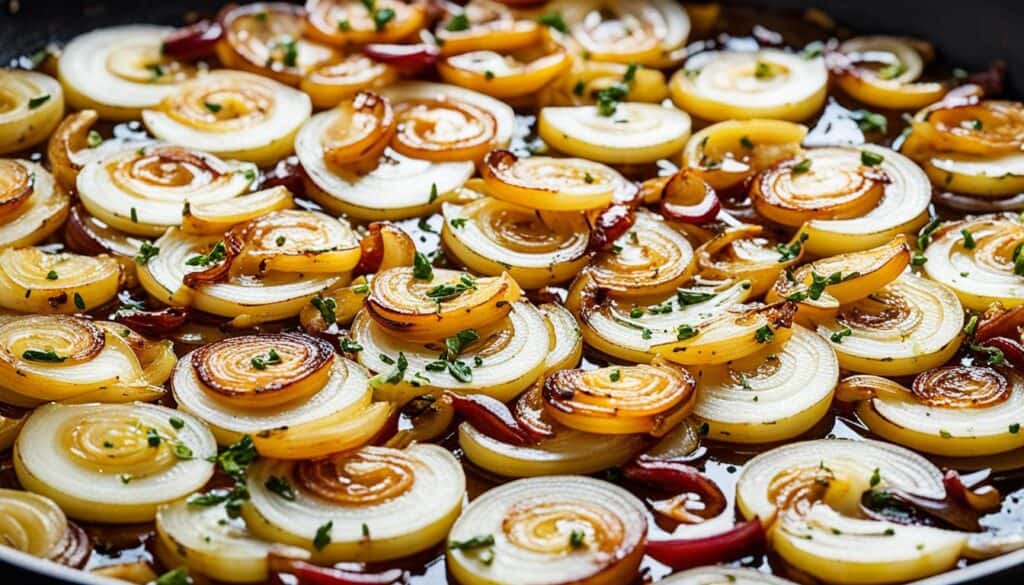
Cooking cipollini onions can be a delicious and flavorful experience. To cook cipollini onions, start by peeling off their papery outer skins. This can be a bit challenging due to their shape, but blanching them in simmering water for a few seconds can make peeling easier. Once peeled, cipollini onions can be used in various recipes, such as stews, roasts, stir-fries, and more.
Blanching Cipollini Onions
Blanching cipollini onions is a simple technique that can help soften their outer layers, making them easier to peel. Here’s how to do it:
- Bring a pot of water to a boil.
- Add the cipollini onions to the boiling water and let them simmer for about 20-30 seconds.
- Using a slotted spoon, remove the onions from the boiling water and transfer them to a bowl of ice water.
- Let the onions cool in the ice water for a few minutes.
- Once cooled, the papery outer skins of the cipollini onions should be easy to remove.
Blanching the onions not only makes peeling easier but also helps to retain their natural flavor and nutrients.
Using Cipollini Onions in Recipes
Now that you have peeled cipollini onions, you can incorporate them into a variety of delicious dishes. Here are some ideas:
- Add caramelized cipollini onions as a topping for burgers or pizzas.
- Roast cipollini onions in the oven with olive oil and spices for a flavorful side dish.
- Sauté cipollini onions with other vegetables in a stir-fry.
- Add them to stews, soups, or braises for added depth of flavor.
- Use them in pasta dishes, omelets, or quiches for a sweet and savory twist.
Experiment with different recipes and cooking methods to explore the versatility of cipollini onions.
Substituting Cipollini Onions
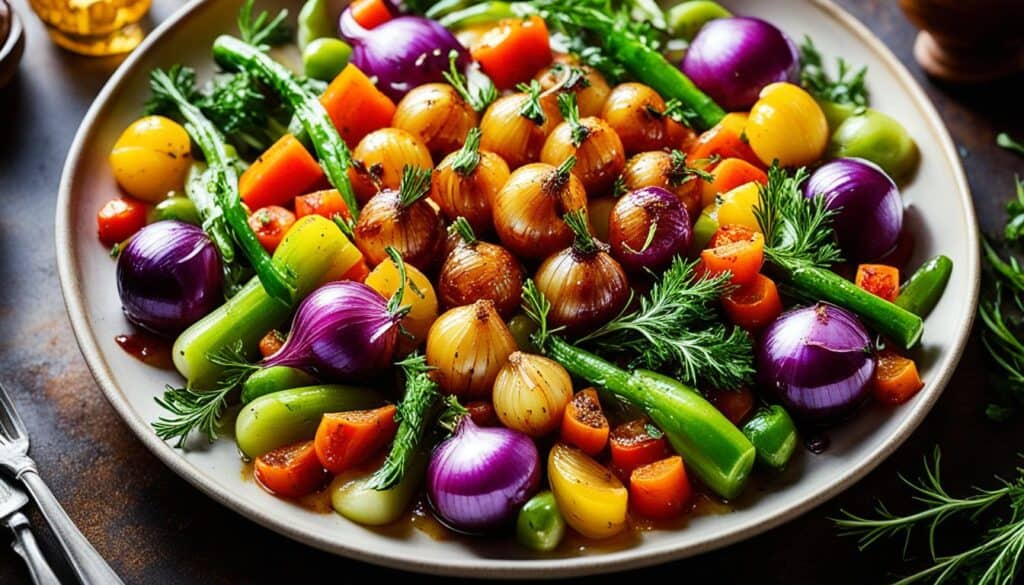
If you can’t find cipollini onions or simply want to try a different variety, there are several substitutes you can use. Shallots, pearl onions, or even regular onions can be used as substitutes for cipollini onions in recipes. Each substitute will bring its own unique flavor profile, so it’s important to consider the overall taste and texture of the dish you’re preparing.
Shallots are a great alternative to cipollini onions as they have a similar mild and sweet flavor. They can be used in the same way as cipollini onions and are especially delicious when caramelized or roasted. Pearl onions, on the other hand, are smaller than cipollini onions but pack a punch of flavor. They can be easily substituted in soups, stews, or even pickled dishes.
“Shallots and pearl onions are excellent substitutes for cipollini onions. They offer their own unique flavors that can elevate your dishes to new heights.”
If you don’t have shallots or pearl onions, regular onions can also work as a substitute. Yellow onions are a good choice as they have a sweeter flavor compared to white or red onions. However, keep in mind that regular onions might have a stronger flavor and a bit more pungency, so adjust the amount used accordingly.
Here’s a quick comparison of cipollini onion substitutes:
| Substitute | Flavor Profile | Usage |
|---|---|---|
| Shallots | Mild and sweet | Caramelizing, roasting, sautéing, pickling |
| Pearl Onions | Strong and flavorful | Soups, stews, pickling |
| Regular Onions (Yellow) | Sweet and pungent | Versatile in various recipes |
Remember, experimenting with different substitutes can bring new flavors and exciting twists to your dishes. So don’t be afraid to get creative in the kitchen and try out different options when cipollini onions aren’t readily available!
Incorporating Cipollini Onions into Your Cooking
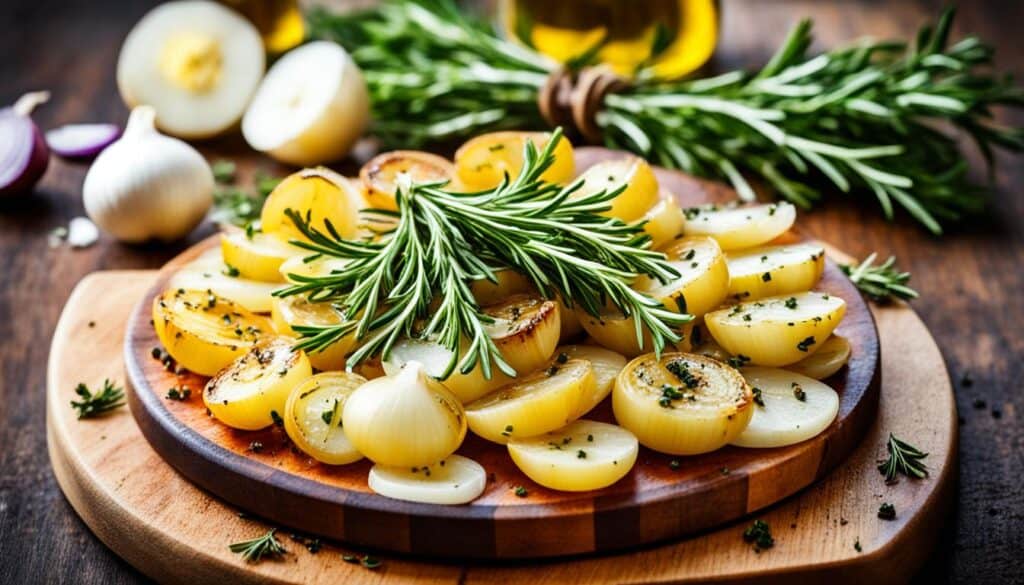
Cipollini onions are an excellent addition to a wide range of dishes, as their sweet flavor can enhance the taste and complexity of your meals. Whether you’re looking to create a simple side dish or a show-stopping main course, cipollini onions can elevate your cooking to new heights. In this section, I will share some creative cipollini onion recipes that you can try at home. Let’s explore the culinary possibilities together!
Pasta with Caramelized Cipollini Onions and Goat Cheese
If you’re a pasta lover, this recipe is for you! Start by caramelizing thinly sliced cipollini onions in a pan with olive oil until they turn golden brown and develop a rich sweet flavor. In the meantime, cook your favorite pasta according to the package instructions. Once the onions are caramelized, toss them with the cooked pasta and crumbled goat cheese. This dish is a perfect balance of savory and sweet, making it a crowd-pleasing choice for any occasion.
Cipollini Onion and Mushroom Tart
This savory tart is a delightful option for a light lunch or dinner. Begin by sautéing thinly sliced cipollini onions and mushrooms in a skillet until they are soft and golden. In a separate bowl, combine eggs, cream, grated cheese, and your favorite herbs to create a custard-like mixture. Place the onion and mushroom mixture onto a pre-baked tart shell, pour the custard mixture over it, and bake until the tart is golden and set. The combination of caramelized onions and earthy mushrooms creates a delicious flavor profile that will impress your guests.
| Recipe | Ingredients | Instructions |
|---|---|---|
| Pasta with Caramelized Cipollini Onions and Goat Cheese |
|
|
| Cipollini Onion and Mushroom Tart |
|
|
These are just a few examples of the wonderful dishes you can create with cipollini onions. Feel free to get creative and experiment with different flavor combinations. The sweet and delicate taste of cipollini onions will shine through in every bite, adding a touch of culinary sophistication to your meals. Enjoy!
Storing and Handling Cipollini Onions
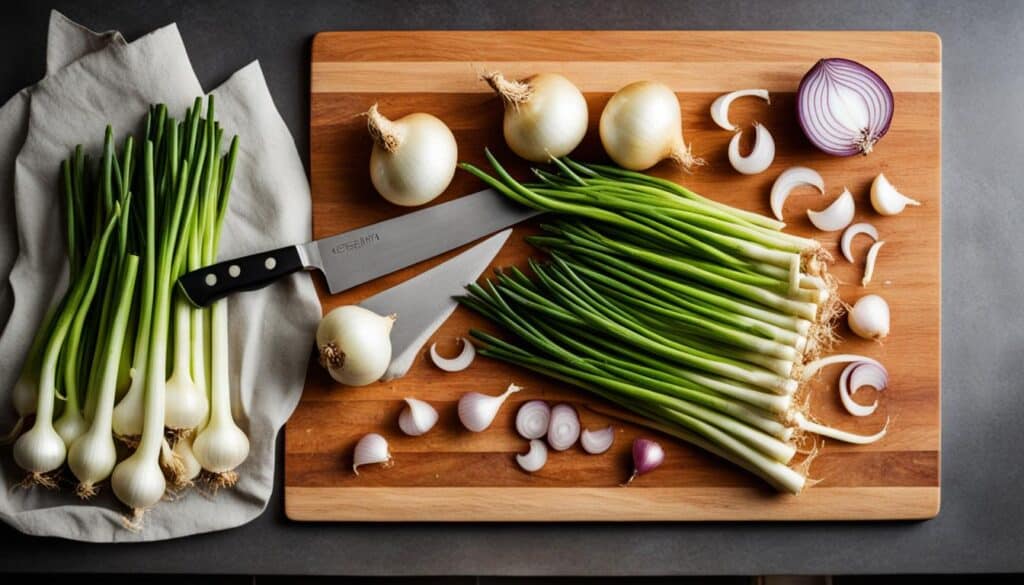
Properly storing cipollini onions is essential to maintain their freshness and flavor. These onions should be stored in a cool, dry, and dark place, such as the bottom of your pantry. The ideal temperature for storing cipollini onions is between 45°F and 55°F (7°C and 13°C). Avoid storing them near potatoes or other vegetables that release moisture, as this can cause the onions to spoil.
If you have leftover peeled cipollini onions, they can be stored in the refrigerator in a plastic or beeswax wrap. This will help prevent them from absorbing odors and keep them fresh for a few days.
When it comes to handling cipollini onions, blanching can help in peeling them easily. To do this, bring a pot of water to a boil and add the whole onions. Let them simmer for about 30 seconds, then drain and transfer them to a bowl of ice water. This blanching process will loosen the skins and make them easier to peel.
If you’re planning to use cipollini onions in a recipe, it’s best to peel and prep them just before cooking to preserve their flavor and texture.
Tips for Storing and Handling Cipollini Onions:
- Store cipollini onions in a cool, dry, and dark place, such as the bottom of your pantry.
- Avoid storing them near other vegetables that release moisture.
- Use plastic or beeswax wrap to store leftover peeled cipollini onions in the refrigerator.
- Blanch whole cipollini onions to make peeling easier.
- Peel and prep cipollini onions just before using them in a recipe for optimal flavor and texture.
Comparing Storage Methods for Cipollini Onions
| Storage Method | Duration | Recommendation |
|---|---|---|
| Stored in a cool, dry, dark place | Up to 2 weeks | Best for long-term storage |
| Stored in the refrigerator | Up to 5 days | Best for short-term storage |
Exploring Other Varieties of Onions
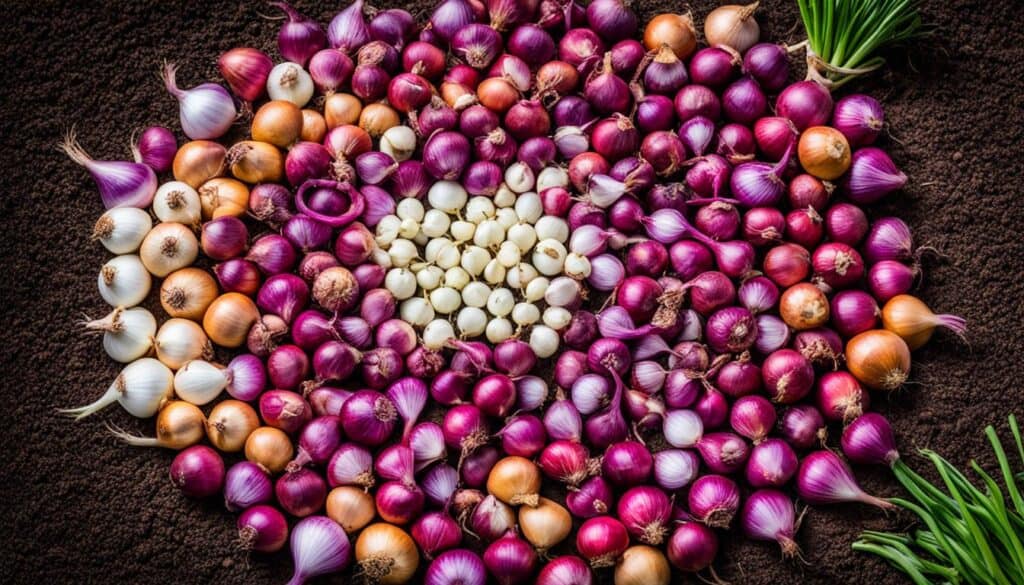
While cipollini onions have their unique flavor and characteristics, it’s worth exploring other varieties of onions to expand your culinary repertoire. Different types of onions, such as yellow onions, white onions, red onions, sweet onions, and spring onions, offer distinct flavors and can bring new dimensions to your dishes.
Yellow Onions: Yellow onions are the most widely used and readily available variety. They have a strong flavor and add a robust taste to dishes. Yellow onions are versatile and can be used in various preparations, including stews, soups, stir-fries, and caramelized onion dishes.
White Onions: White onions have a milder flavor compared to yellow onions. They have a slightly sweet taste and a crisp texture, making them ideal for fresh salsas, salads, and sandwiches. White onions are also popular in Mexican cuisine, where their subtle flavor enhances traditional dishes like pico de gallo and guacamole.
Red Onions: Red onions have a vibrant hue and a slightly milder flavor than yellow onions. They are commonly used in salads, sandwiches, and garnishes due to their appealing color and mild sweetness. Red onions also retain their crisp texture when pickled, making them a popular choice for relishes and pickled condiments.
Sweet Onions: Sweet onions, such as Vidalia, Walla Walla, and Maui onions, have a mild and sweet flavor. They are less pungent than other onion varieties and work well in dishes where a milder taste is desired. Sweet onions are often enjoyed raw in salads, sandwiches, and as toppings for burgers or grilled meats.
Spring Onions: Spring onions, also known as scallions or green onions, have a refreshing, mild flavor. They have edible green leaves and a small, round white bulb. Spring onions are commonly used as a garnish, added to stir-fries, noodle dishes, and salads, and can even be grilled or roasted for a delightful side dish.
Each variety of onion brings its own unique taste and texture to your culinary creations. Experimenting with different onions can add depth and complexity to your favorite recipes. Try incorporating yellow onions for a robust flavor, white onions for a subtle sweetness, red onions for a vibrant color, sweet onions for a milder taste, and spring onions for a refreshing crunch.
Now, let’s take a closer look at the key characteristics of each onion variety and their best uses in the table below:
| Onion Variety | Flavor | Best Uses |
|---|---|---|
| Yellow Onions | Strong, robust | Stews, soups, stir-fries, caramelized dishes |
| White Onions | Mild, slightly sweet | Fresh salsas, salads, sandwiches |
| Red Onions | Mild, slightly sweeter than yellow onions | Salads, sandwiches, pickled condiments |
| Sweet Onions | Mild, sweet | Raw in salads, sandwiches, burger toppings |
| Spring Onions | Refreshing, mild | Garnish, stir-fries, noodle dishes, salads |
Exploring the variety of onions available allows you to tailor your dishes to your taste preferences and experiment with new flavors. Incorporating different onion varieties can elevate the taste of your recipes and bring a delightful twist to your favorite dishes.
Conclusion
Cipollini onions are a delightful addition to any kitchen, bringing a burst of flavor and versatility to your dishes. Their unique disc-like shape and sweet taste make them a favorite amongst both professional chefs and home cooks. Whether you’re caramelizing them to enhance their sweetness, roasting them for a delicious side dish, or pickling them for a tangy twist, cipollini onions are sure to elevate your culinary creations.
In addition to their fantastic flavor, cipollini onions also offer numerous health benefits. Packed with vitamins and minerals like vitamin C, vitamin B6, and potassium, these onions contribute to a nutritious diet. They are also a great source of antioxidants, which can help protect against chronic diseases. With their low calorie count and dietary fiber content, cipollini onions are a healthy and delicious choice.
Throughout this article, I have provided a comprehensive guide to savoring cipollini onions. From cooking techniques to their benefits and possible substitutes, you now have all the information you need to make the most of these flavorful onions. So, embrace the culinary adventure and enjoy the rich flavors that cipollini onions bring to your cooking. Get creative, try new recipes, and let these delightful onions take your dishes to a whole new level.

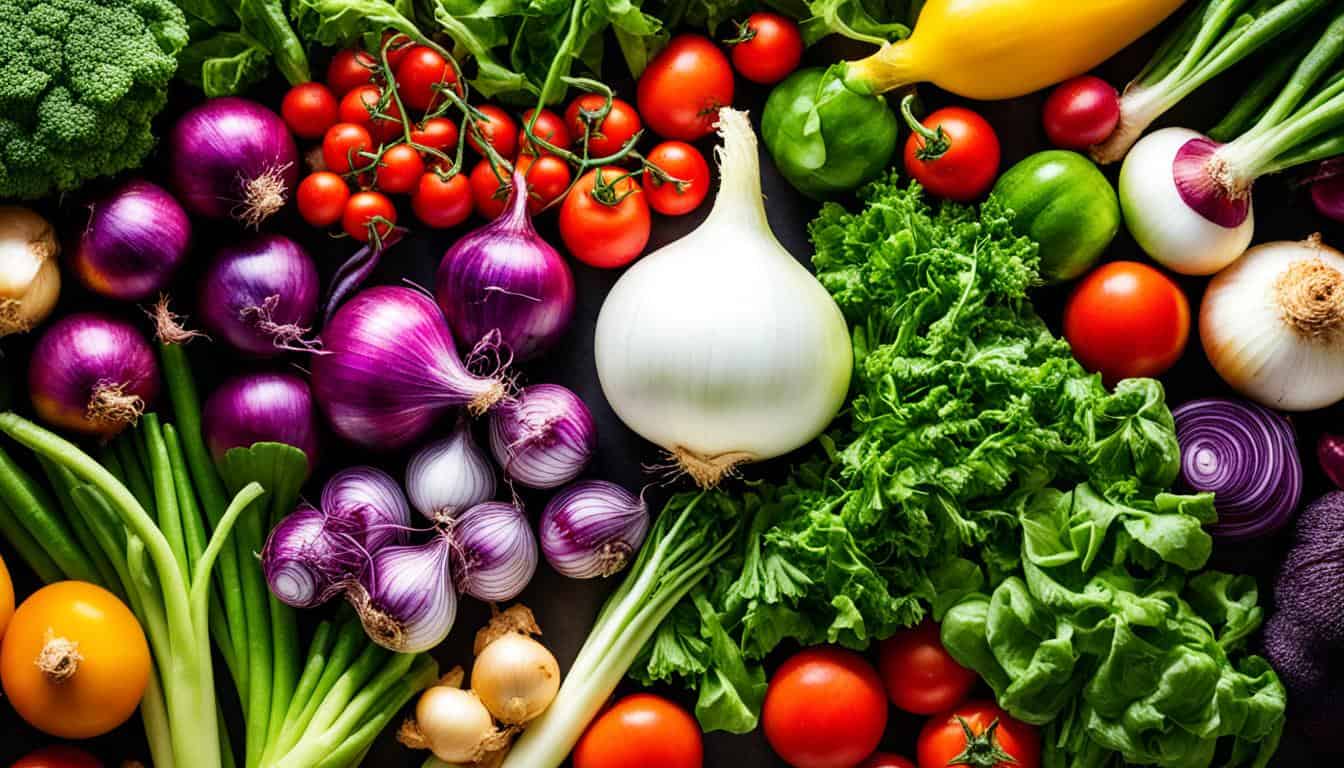



Leave a Reply